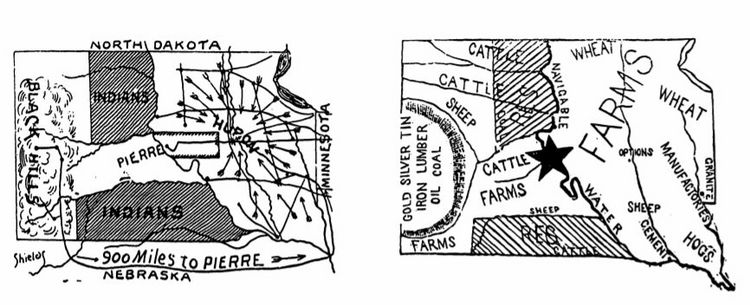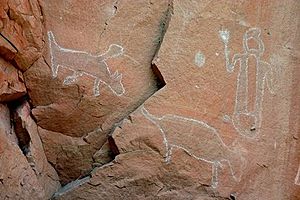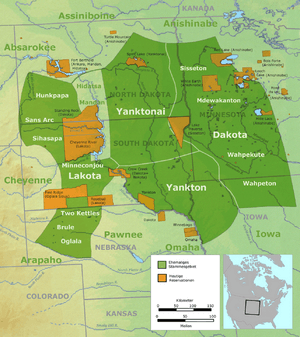History of South Dakota facts for kids
The history of South Dakota tells the story of the U.S. state of South Dakota over thousands of years. It covers everything from its first people to the challenges the state faces today. The famous explorers Lewis and Clark helped explore this area.
Contents
Early People in South Dakota
People have lived in the area we now call South Dakota for thousands of years. The first hunters arrived in North America at least 17,000 years ago. They crossed a land bridge called Beringia, which connected Siberia and Alaska during the last ice age. These early settlers were nomadic hunter-gatherers. This means they moved around to find food. They used simple tools from the Stone Age to hunt large animals like mammoths, sloths, and camels. This way of life changed around 5000 BC when many of these large animals died out.
Between AD 500 and 800, a group called the 'Mound Builders' lived in eastern South Dakota. They were hunters who lived in temporary villages. They are named for the low earthen mounds they built to bury their dead. Many of these mounds can still be seen today. They mostly lived near the Big Sioux River and Big Stone Lake. By the year 800, the Mound Builders disappeared, either by joining other groups or through conflict. Later, between 1250 and 1400, farming people arrived from the east. These were likely the ancestors of the modern Mandan people of North Dakota. They settled in the central part of the state. Around 1325, a terrible event known as the Crow Creek massacre happened near Chamberlain. Archaeologists found 486 bodies buried together in a fortified village.
Arikara Tribe: Farmers and Traders
The Arikara people, also called the Ree, started arriving from the south in the 1500s. They spoke a language similar to the Pawnee and probably came from what is now Kansas and Nebraska. The Arikara were not as nomadic as other tribes. They mostly lived in permanent villages. These villages had strong fences (stockades) around circular earth lodges. These lodges were often built on hills overlooking rivers. Each village had its own leaders, and the Arikara tribes were loosely connected. Besides hunting, they grew crops like corn, beans, and pumpkins. They were also skilled traders. They often traded goods between tribes to the north and south. Spanish horses likely reached the region around 1760 through their trading networks. The Arikara were strongest in the 1600s, with perhaps as many as 32 villages. But due to diseases and pressure from other tribes, their numbers dropped. By the late 1700s, only two Arikara villages remained, and they eventually joined with the Mandan people.
Sioux Tribe: Moving to the Plains
By the 1600s, the Sioux people, who would later become very powerful in the state, lived in central and northern Minnesota. The Sioux spoke a language from the Siouan family. They were divided into four main groups: the Santee, the Yankton, the Yanktonnais, and the Lakota (also known as the Teton). At this time, the Sioux lived more like people from the eastern woodlands. They traveled by boat and gathered wild rice and berries to add to their hunted food. They lived in earth and wood lodges, not the tipis often seen on the plains.
However, in the late 1600s and early 1700s, the Sioux began to move south and then west onto the plains. This happened for several reasons. There was more food available to the west, and rival tribes like the Cree had obtained rifles from the French, while the Sioux still used bows and arrows. As they moved west onto the prairies, the Sioux's way of life changed a lot. They became more like nomadic plains tribes. They relied more on bison for food, used horses for travel, and started living in tipis. Tipis were much better for people who moved often.
The four Sioux groups settled in different parts of the northern plains. The Lakota crossed the Missouri River around 1760 and reached the Black Hills by 1776. They settled mostly in western South Dakota, northwestern Nebraska, and southwestern North Dakota. The Yankton mainly settled in southeastern South Dakota. The Yanktonnais settled in northeastern South Dakota and southeastern North Dakota. The Santee stayed mostly in central and southern Minnesota. Because the Sioux moved, many other tribes were pushed out of the area. The Cheyenne were pushed west from the Black Hills. The Arikara moved further north along the Missouri River. The Omaha were driven out of southeastern South Dakota into northeastern Nebraska.
European Explorers Arrive
French Claims in South Dakota
France was the first European country to claim the land that would become South Dakota. Their claims covered most of the modern state. However, only a few French explorers might have entered eastern South Dakota. In 1679, Daniel G. Duluth sent explorers west from Lake Mille Lacs. They might have reached Big Stone Lake and the Coteau des Prairies. Traders working for Pierre Le Sueur also visited the Big Sioux River valley many times. A map from 1701 by William De L'Isle shows a trail from the Mississippi River to the falls of the Big Sioux River, which supports these journeys.
After 1713, France looked west to keep its fur trade going. The first Europeans to enter South Dakota from the north were the Verendrye brothers. They started their journey in 1743 from Fort La Reine on Lake Manitoba. They were trying to find a water route all the way to the Pacific Ocean. They buried a lead plate with an inscription near Fort Pierre. Schoolchildren found it again in 1913.
Spanish Control and Exploration
In 1762, France secretly gave all its land west of the Mississippi River to Spain. This was part of the Treaty of Fontainebleau. France wanted Spain to make peace with Britain after the Seven Years' War. To protect against British expansion, Spain focused on trading more with local tribes and exploring the upper Missouri River. They also hoped to find a water route to the Pacific Ocean. Traders like Jacques D'Eglise and Juan Munier had been active in the area for years. But Spain had not made a strong effort to explore the region.
In 1793, a group called the Missouri Company was formed in St. Louis. Their goals were to trade and explore the upper Missouri. They tried several times to reach the Pacific Ocean, but none got further than the mouth of the Yellowstone. In 1794, Jean Truteau built a cabin near where Fort Randall is today. In 1795, the Mackay-Evans Expedition traveled up the Missouri into North Dakota. There, they forced out British traders. In 1801, a trading post called Fort aux Cedres was built by Registre Loisel. It was on Cedar Island, about 35 miles (56 km) southeast of Pierre. This was the main trading post until it burned down in 1810. In 1800, Spain gave Louisiana back to France in the Treaty of San Ildefonso.
American Exploration of South Dakota
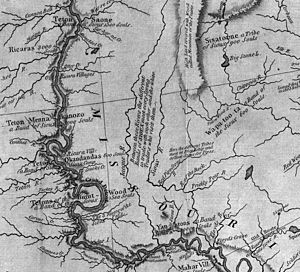
In 1803, the United States bought the Louisiana Territory from Napoleon for $11 million. This huge area included most of the western half of the Mississippi River watershed. It covered almost all of present-day South Dakota, except for a small part in the northeast. The region was still mostly unknown. President Thomas Jefferson organized the Lewis and Clark Expedition to explore this new land. The expedition, also known as the Corps of Discovery, lasted over two years. Their mission was to follow the Missouri River to its source, continue to the Pacific Ocean, make friends with the local tribes, and map the area. They also studied the geology and plants.
The expedition left St. Louis on May 14, 1804, with 45 men and 15 tons of supplies. They traveled slowly against the Missouri's current. They reached what is now South Dakota on August 22. Near Vermillion, they hiked to the Spirit Mound Historic Prairie. They had heard local stories about "little spirits" living there. Soon after, they had a peaceful meeting with the Yankton Sioux. However, an encounter with the Lakota Sioux further north was more difficult. The Lakota thought the explorers were traders and even stole a horse. Weapons were shown on both sides when it seemed the Lakota might stop the expedition. But eventually, the Lakota backed down and let them continue up the river. In north-central South Dakota, the expedition helped the Arikara and Mandan tribes make peace. The explorers left South Dakota on October 14. They spent the winter with the Mandan in North Dakota before reaching the Pacific Ocean. They returned by the same route, arriving safely back in St. Louis in 1806. On the way back, they spent only 15 days in South Dakota, traveling much faster with the river's current.
Pittsburgh lawyer Henry Marie Brackenridge was the first recorded tourist in South Dakota. In 1811, fur trader Manuel Lisa hosted him.
Fur Trading in South Dakota
In 1817, an American fur trading post was set up at what is now Fort Pierre. This marked the beginning of continuous American settlement in the area. During the 1830s, fur trading was the main business for the few white people living there. More than a hundred fur-trading posts existed in present-day South Dakota in the first half of the 1800s. Fort Pierre was the busiest center. Important fur traders like General William Henry Ashley, Andrew Henry, and Jedediah Smith from the Rocky Mountain Fur Company, and Manuel Lisa and Joshua Pilcher from the St. Louis Fur Company, trapped in the region.
Pierre Chouteau, Jr. brought the steamship Yellowstone to Fort Tecumseh on the Missouri River in 1831. In 1832, Fort Tecumseh was replaced by Fort Pierre Chouteau, Jr., which is today's town of Fort Pierre. Pierre Chouteau, Jr. bought the Western Department of John Jacob Astor's American Fur Company. He renamed it Pratte, Chouteau and Company, and later Pierre Chouteau and Company. This company operated in South Dakota from 1834 to 1858. Most trappers and traders left the area after 1840, when Europeans wanted fewer furs.
American Settlement and Statehood
In 1855, the U.S. Army bought Fort Pierre. But they left it the next year for Fort Randall to the south. More and more Americans and Europeans were settling in the area. In 1858, the Yankton Sioux signed the 1858 Treaty. This gave most of eastern South Dakota to the United States.
Land developers started two of eastern South Dakota's largest cities today: Sioux Falls in 1856 and Yankton in 1859. A settlement was started at the Big Sioux River falls in 1856 by a company from Dubuque, Iowa. Native residents quickly removed that town. But in May 1857, the town was resettled and named Sioux Falls. That June, the Dakota Land Company from St. Paul, Minnesota started another town nearby called Sioux Falls City. In June 1857, Flandreau and Medary, South Dakota, were also established by the Dakota Land Company. Along with Yankton in 1859, other new communities like Bon Homme, Elk Point, and Vermillion grew along the Missouri River or near the Minnesota border. By 1860, about 5,000 settlers lived there.
In 1861, the Dakota Territory was created by the U.S. government. This territory first included North Dakota, South Dakota, and parts of Montana and Wyoming. Settlers from Scandinavia, Germany, Ireland, Russia, and other parts of Europe and the eastern U.S. states arrived in large numbers. This increased even more after a railway link to the capital, Yankton, was completed in 1872. The discovery of gold in the Black Hills in 1874 during a military trip led by George A. Custer also brought many people.
The growing population led to the Dakota Territory being split in half. A bill for statehood for North Dakota and South Dakota (as well as Montana and Washington) was passed on February 22, 1889. This was called the Enabling Act of 1889. President Benjamin Harrison then signed papers formally making North and South Dakota states on November 2, 1889. Harrison told his Secretary of State James G. Blaine to mix up the papers so he wouldn't know which state he was signing in first. So, the actual order of admission was never recorded.
Conflict Over Land
The 1874 Custer expedition happened even though the western half of present-day South Dakota had been given to the Sioux. This was part of the Great Sioux Reservation under the Treaty of Fort Laramie. The Sioux did not want to give mining rights or land in the Black Hills. The Great Sioux War of 1876 started after the U.S. failed to stop white miners and settlers from entering the area. The Sioux were eventually defeated and settled on reservations in South Dakota and North Dakota.
In 1889, President Harrison sent General George Crook with a group to convince the Sioux to sell half of their reservation land to the government. It was thought that the new state would not be successful unless more land was available to settlers. Crook used some questionable methods to get the agreement and obtain the land.
On December 29, 1890, the Wounded Knee Massacre took place on the Pine Ridge Indian Reservation. This event is often called the last major armed conflict between the United States and the Sioux Nation. About 300 Sioux people were killed. 25 U.S. soldiers also died in the conflict.
Railroads and Growth
Railroads were very important for transportation in South Dakota from the late 1800s until the 1930s. After that, highways became more popular. The Milwaukee Road and the Chicago & North Western were the biggest railroads in the state. The Milwaukee's main line crossed the northern part of the state from east to west. About 4,420 miles (7,110 km) of railroad track were built in South Dakota in the late 1800s and early 1900s. However, only 1,839 miles (2,960 km) were still in use by 2007.
The railroads sold land to farmers at very low prices. They expected to make money by shipping farm products out and bringing home goods in. They also created small towns to be shipping points and business centers. These towns attracted business people and more farmers. In 1905, the Minneapolis and St. Louis Railway (M&StL) added lines from Watertown to LeBeau and from Conde through Aberdeen to Leola. It developed new towns along these lines. By 1910, the new lines served 35 small communities.
Not all of these new towns survived. The M&StL placed LeBeau along the Missouri River, on the eastern edge of the Cheyenne River Indian Reservation. This new town became a center for the cattle and grain industries. Livestock worth one million dollars was shipped out in 1908. The rail company even planned a bridge across the Missouri River. Dividing the Cheyenne River Reservation in 1909 promised even more growth. However, by the early 1920s, problems grew. A local rancher was murdered, a fire destroyed the business district, and a drought ruined ranchers and farmers. LeBeau eventually became a ghost town.
Most of the railroad traffic was for freight, but the main lines also offered passenger service. After European immigrants settled, not many people moved around within the state. Profits for passenger service were small. Cars and buses became much more popular. However, train travel increased during World War II when gasoline was hard to get. All passenger train service in the state ended by 1960.
Shopping in South Dakota
In rural areas, farmers and ranchers depended on local general stores. These stores had a limited selection of goods and sold things slowly. They made enough money by selling at high prices. Prices were not marked on each item. Instead, customers would bargain for a price. Men usually did most of the shopping. The most important thing was getting credit, not the quality of the goods. Most customers bought on credit, paying their bills after they sold their crops or cattle. So, the store owner's ability to judge if someone would pay them back was very important for their success.
In the cities, people had many more choices. They bought their clothes and supplies at local department stores. These stores had a much wider selection of goods than country general stores. They also had price tags showing the actual selling price. Department stores offered very limited credit. They set up attractive displays, and after 1900, they also had window displays. Their clerks, usually men before the 1940s, were experienced salespeople. Their knowledge of products appealed to middle-class housewives, who usually did most of the shopping. The keys to success were a large variety of good quality, brand-name products, selling things quickly, fair prices, and frequent special sales. Larger stores sent their buyers to Denver, Minneapolis, and Chicago once or twice a year. They would check out the newest trends and buy the latest fashions. By the 1920s and 1930s, large mail-order companies like Sears, Roebuck & Co. and Montgomery Ward became strong competitors. This made department stores rely even more on good salesmanship and being closely connected to the community.
Many business owners built stores, shops, and offices along Main Street. The most attractive ones used pre-formed, sheet iron fronts. These were often made by the Mesker Brothers of St. Louis. These fancy, classical-style fronts added a touch of class to brick or wood-frame buildings across the state.
The Dust Bowl Years
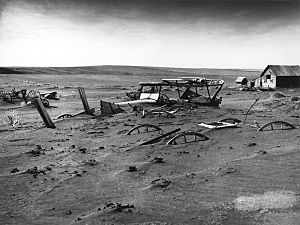
During the 1930s, several economic and weather problems hit South Dakota hard. There wasn't enough rain, temperatures were extremely high, and farmland was over-cultivated (farmed too much without letting the soil rest). This created what was known as the Dust Bowl in South Dakota and other plains states. Rich topsoil was blown away in huge dust storms. Several harvests were completely ruined. The Dust Bowl, along with local bank foreclosures (when banks take back property because loans aren't paid), and the general effects of the Great Depression, caused many South Dakotans to leave the state. South Dakota's population dropped by more than seven percent between 1930 and 1940.
World War II and Modern Times
Good times returned when the U.S. entered World War II in 1941. Demand for the state's farm products and industrial goods grew as the country prepared for war. Over 68,000 South Dakotans served in the armed forces during the war, and over 2,200 of them were killed.
Building Dams
In 1944, the Pick-Sloan Plan was passed by the U.S. Congress as part of the Flood Control Act of 1944. This led to the building of six large dams on the Missouri River. Four of these dams are at least partly in South Dakota. These dams and their reservoirs help control floods, produce hydroelectricity (power from water), and offer fun activities like boating and fishing.
On the night of June 9–10, 1972, heavy rainfall in the eastern Black Hills caused the Canyon Lake Dam on Rapid Creek to break. The dam's failure, along with a lot of rain, turned the usually small creek into a huge, fast-moving river. This torrent washed through central Rapid City. The flood killed 238 people and destroyed 1,335 homes and about 5,000 cars. The damage from the flood was $160 million (which would be about $664 million today).
On April 19, 1993, Governor George Mickelson died in a plane crash in Iowa. He was returning from a business meeting. Several other state officials also died in the crash. Mickelson was in the middle of his second term as governor. He was replaced by Walter Dale Miller.


